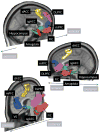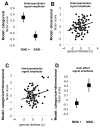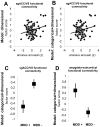Neurobiological signatures of anxiety and depression in resting-state functional magnetic resonance imaging
- PMID: 25444162
- PMCID: PMC4297561
- DOI: 10.1016/j.biopsych.2014.08.006
Neurobiological signatures of anxiety and depression in resting-state functional magnetic resonance imaging
Abstract
Background: There is increasing interest in using neurobiological measures to inform psychiatric nosology. It is unclear at the present time whether anxiety and depression are neurobiologically distinct or similar processes. It is also unknown if the best way to examine these disorders neurobiologically is by contrasting categorical definitions or by examining symptom dimensions.
Methods: A cross-sectional neuroimaging study was conducted of patients with generalized anxiety disorder (GAD), major depressive disorder (MDD), comorbid GAD and MDD (GAD/MDD), or neither GAD nor MDD (control subjects). There were 90 participants, all medication-free (17 GAD, 12 MDD, 23 GAD/MDD, and 38 control subjects). Diagnosis/category and dimensions/symptoms were assessed to determine the best fit for neurobiological data. Symptoms included general distress, common to anxiety and depression, and anxiety-specific (anxious arousal) or depression-specific (anhedonia) symptoms. Low-frequency (.008-.1 Hz) signal amplitude and functional connectivity analyses of resting-state functional magnetic resonance imaging data focused on a priori cortical and subcortical regions of interest.
Results: Support was found for effects of diagnosis above and beyond effects related to symptom levels as well as for effects of symptom levels above and beyond effects of diagnostic categories. The specific dimensional factors of general distress and anxious arousal as well as a diagnosis of MDD explained unique proportions of variance in signal amplitude or functional connectivity.
Conclusions: Using resting-state functional magnetic resonance imaging, our data show that a single conceptual model alone (i.e., categorical diagnoses or symptom dimensions) provides an incomplete mapping of psychopathology to neurobiology. Instead, the data support an additive model that best captures abnormal neural patterns in patients with anxiety and depression.
Keywords: Anhedonia; Anxiety; Depression; Neuroimaging; Resting state; fMRI.
Published by Elsevier Inc.
Figures




Similar articles
-
Investigating distinct and common abnormalities of resting-state functional connectivity in depression, anxiety, and their comorbid states.Eur Neuropsychopharmacol. 2015 Nov;25(11):1933-42. doi: 10.1016/j.euroneuro.2015.08.002. Epub 2015 Aug 11. Eur Neuropsychopharmacol. 2015. PMID: 26321187
-
Stratification of MDD and GAD patients by resting state brain connectivity predicts cognitive bias.Neuroimage Clin. 2018 Apr 30;19:425-433. doi: 10.1016/j.nicl.2018.04.033. eCollection 2018. Neuroimage Clin. 2018. PMID: 30035026 Free PMC article.
-
Abnormal multi-layered dynamic cortico-subcortical functional connectivity in major depressive disorder and generalized anxiety disorder.J Psychiatr Res. 2023 Nov;167:23-31. doi: 10.1016/j.jpsychires.2023.10.004. Epub 2023 Oct 6. J Psychiatr Res. 2023. PMID: 37820447
-
Spatiotemporal psychopathology I: No rest for the brain's resting state activity in depression? Spatiotemporal psychopathology of depressive symptoms.J Affect Disord. 2016 Jan 15;190:854-866. doi: 10.1016/j.jad.2015.05.007. Epub 2015 May 14. J Affect Disord. 2016. PMID: 26048657 Review.
-
Resting-state neuroimaging studies: a new way of identifying differences and similarities among the anxiety disorders?Can J Psychiatry. 2014 Jun;59(6):294-300. doi: 10.1177/070674371405900602. Can J Psychiatry. 2014. PMID: 25007403 Free PMC article. Review.
Cited by
-
Connectomics-based resting-state functional network alterations predict suicidality in major depressive disorder.Transl Psychiatry. 2023 Nov 27;13(1):365. doi: 10.1038/s41398-023-02655-4. Transl Psychiatry. 2023. PMID: 38012129 Free PMC article.
-
The association between a history of anxiety or depression and utilization of diagnostic imaging.PLoS One. 2021 Jul 12;16(7):e0254572. doi: 10.1371/journal.pone.0254572. eCollection 2021. PLoS One. 2021. PMID: 34252170 Free PMC article.
-
Aberrant Spontaneous and Task-Dependent Functional Connections in the Anxious Brain.Biol Psychiatry Cogn Neurosci Neuroimaging. 2016 May;1(3):278-287. doi: 10.1016/j.bpsc.2015.12.004. Biol Psychiatry Cogn Neurosci Neuroimaging. 2016. PMID: 27141532 Free PMC article.
-
Neural systems and hormones mediating attraction to infant and child faces.Front Psychol. 2015 Jul 17;6:970. doi: 10.3389/fpsyg.2015.00970. eCollection 2015. Front Psychol. 2015. PMID: 26236256 Free PMC article. Review.
-
Anterior Cingulate Cortex Implants for Alcohol Addiction: A Feasibility Study.Neurotherapeutics. 2020 Jul;17(3):1287-1299. doi: 10.1007/s13311-020-00851-4. Neurotherapeutics. 2020. PMID: 32323203 Free PMC article. Clinical Trial.
References
-
- Insel T, Cuthbert B, Garvey M, Heinssen R, Pine DS, Quinn K, et al. Research domain criteria (RDoC): toward a new classification framework for research on mental disorders. Am J Psychiatry. 2010;167:748–751. - PubMed
-
- Brown TA, Campbell LA, Lehman CL, Grisham JR, Mancill RB. Current and lifetime comorbidity of the DSM-IV anxiety and mood disorders in a large clinical sample. J Abnorm Psychol. 2001;110:585–599. - PubMed
-
- Kendler KS, Neale MC, Kessler RC, Heath AC, Eaves LJ. Major depression and generalized anxiety disorder. Same genes, (partly) different environments? Arch Gen Psychiatry. 1992;49:716–722. - PubMed
-
- Roy MA, Neale MC, Pedersen NL, Mathe AA, Kendler KS. A twin study of generalized anxiety disorder and major depression. Psychol Med. 1995;25:1037–1049. - PubMed
Publication types
MeSH terms
Grants and funding
LinkOut - more resources
Full Text Sources
Other Literature Sources
Medical

